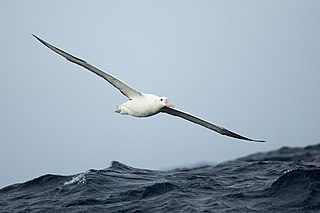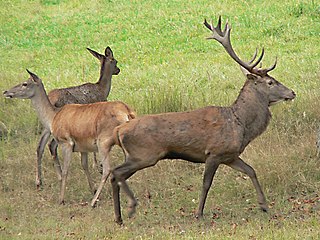
Onchocerciasis, also known as river blindness, is a disease caused by infection with the parasitic worm Onchocerca volvulus. Symptoms include severe itching, bumps under the skin, and blindness. It is the second-most common cause of blindness due to infection, after trachoma.

Onchocerca volvulus is a filarial (arthropod-borne) nematode (roundworm) that causes onchocerciasis, and is the second-leading cause of blindness due to infection worldwide after trachoma. It is one of the 20 neglected tropical diseases listed by the World Health Organization, with elimination from certain countries expected by 2025.

Pituophis is a genus of nonvenomous colubrid snakes, commonly referred to as gopher snakes, pine snakes, and bullsnakes, which are endemic to North America.

The Antipodean albatross is a large seabird in the albatross family. Antipodean albatrosses are smaller than snowy albatrosses, and breed in predominantly brown plumage, but are otherwise difficult to distinguish from young snowy albatrosses.

The red-billed emerald is a species of hummingbird in the "emeralds", tribe Trochilini of subfamily Trochilinae. It is found in Colombia and Venezuela.
Mansonelliasis is the condition of infection by the nematode Mansonella. The disease exists in Africa and tropical Americas, spread by biting midges or blackflies. It is usually asymptomatic.

Onchocerca is a genus of parasitic roundworm. It contains one human parasite – Onchocerca volvulus – which is responsible for the neglected disease Onchocerciasis, also known as "river blindness" because the infected humans tend to live near rivers where host black flies live. Over 40 million people are infected in Africa, Central America, and South America. Other species affect cattle, horses, etc.
Elaeophora bohmi is a nematode parasite found in various arteries of the horse. The adult males are 44-55 mm long and 95 µm wide, while adult females can be over 12 cm long and 210 µm wide. Microfilariae are not sheathed, and measure 300-330 µm long and 6-7 µm wide. The life cycle and clinical symptoms of infestation by E. bohmi have not been described.

The Onchocercidae are a family of nematodes in the superfamily Filarioidea. This family includes some of the most devastating human parasitic diseases, such as lymphatic filariasis, onchocerciasis, loiasis, and other filariases.
Afrocyclops gibsoni is a species of copepod in the family Cyclopidae. Three subspecies have been identified:

Onchocerca tubingensis is the name of a nematode. It was discovered in 1974 and published by O. Bain und H. Schulz-Key in Tropenmedizin und Parasitologie and named after Tübingen. Red deer are the host of this parasite. The adult worms of Onchocerca tubingensis are found in subcutaneous nodules on the caudal part of the back, while the microfilariae are distributed on the ventral part of the body with maximum densities in the region of the sternum and with lower densities on the inner sides of the hindlegs. The infection rates of 94 red deer investigated in southern Germany during 1907–1974 were 23%.
Copelatus gibsoni is a species of diving beetle. It is part of the genus Copelatus in the subfamily Copelatinae of the family Dytiscidae. It was described by Vazirani in 1974.

Gibson's albatross, also known as the Auckland Islands wandering albatross or Gibson's wandering albatross, is a large seabird in the great albatross group of the albatross family. The common name and trinomial commemorate John Douglas Gibson, an Australian amateur ornithologist who studied albatrosses off the coast of New South Wales for thirty years.
Septesinus is a genus of monopisthocotylean monogeneans which currently comprises a single species, Septesinus gibsoni

Epiblema gibsoni is a species of moth of the family Tortricidae. It is found in North America, where it has been recorded from Arkansas, Illinois, Indiana, Kentucky, Michigan, Mississippi, Missouri, Ohio, North Carolina and South Carolina.
Onchocerca lupi is a nematode that causes ocular onchocerciasis, an eye disease, in canines and felines. The parasite was first described in 1967 in a wolf from Georgia. The other Onchocerca spp., O. volvulus, is a human parasite that causes ocular onchocerciasis in human and affects 37 million people globally.

Thomas Harvey Johnston was an Australian biologist and parasitologist. He championed the efforts to eradicate the invasive prickly pear.
Discoverytrema is a genus of trematodes in the family Opecoelidae. K. Zdzitowiecki described both species of Discoverytrema as being endoparasitic in the Antarctic gadiform fish Muraenolepis microps Lönnberg, 1905, which are found to the south of the British South Georgia Island.

Pituophis lineaticollis, commonly known as the Middle American gopher snake or the cincuate bull snake, is a species of nonvenomous snake in the family Colubridae. The species is native to Guatemala and southeastern Mexico. There are two recognized subspecies.
Onchocerca gutturosa is a species of nematodes belonging to the family Onchocercidae.










